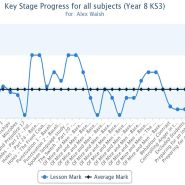Ofsted. For teachers and educational professionals, it’s the single word that can strike fear into hearts; for parents, carers and guardians, it’s often considered the Holy Grail of a school’s quality – the be all, and end all. However truly defining what makes a school ‘Outstanding’, may not be such a simple matter. As we’ll go on to discover, this seal of quality is often not such a straightforward concept.
A gloomy outlook for schooling today?
If we were to go by the official outcome of the latest Ofsted ratings, then it would appear that UK secondary schools may never have had it so bad.
Officially, the latest Ofsted round has resulted in only 57% of secondary schools achieving either a ‘good or outstanding rating’ (Telegraph 2016). Most notable about these figures is that they are of stark contrast to the year previous, when 73% were rated as outstanding (TES 2015).
Yet these figures must be considered against a back drop of education that has seen its most turbulent few years – amid legislative change after legislative change, and at a time when teacher turnover and dissatisfaction have never been more concerning. This all clouds the issue, making it difficult to determine just what’s truly behind such a significant fall.
‘Outstanding’ – The official word from Ofsted
Moving on to defining the coveted ‘Outstanding’ certification, let’s begin by grappling with the rating as defined by the all-seeing, all-powerful Ofsted organisation itself.
Any Ofsted rating is defined by a number of complex elements, including:
- Overall effectiveness
- Effectiveness of leadership and management
- Quality of teaching, learning and assessment
- Personal development, behaviour and welfare
- Outcomes for pupils
You can read the complete breakdown of these criteria, and background as to how schools are inspected, in the Ofsted School Inspection Handbook.
An ‘Outstanding’ lesson
So, what exactly would an ‘Outstanding’ lesson look like? Well, amongst no less than 29 different so-called ‘habits’ (which span environment, learning, teacher’s habits and children’s habits), inspectors look out for:
Environment
“A very positive, purposeful atmosphere pervades all aspects of learning and behaviour within the class”
Learning
“Carefully chosen pieces of work, one of which that demonstrates high achievement, are used to stimulate and exemplify success”
Teacher’s habits
“The teacher uses their in-depth subject knowledge to support learning, support able pupils and extend learning for all”.
Children’s habits
“Effective use of dialogue, including modelling, within the classroom ensures that all children have opportunities to express and discuss aspects of their learning, including with the teacher”.
‘Outstanding’ – Going beyond the text book answer
The complete breakdown as to what an outstanding rating actually looks like in real life is beyond the scope of this blog – and actually, when we ask what ‘Outstanding’ really is, we’d truly miss the point if we didn’t go beyond this deceiving text book answer. Let’s dig into this a little deeper…
GCSE Attainment and Ofsted rating
If the outcomes of secondary school pupils where really so reliant on Ofsted ratings, then Ofsted grades throughout the land would be clearly linked to the exam results achieved by schools. So, is this the case? When we look at a Governmental report into student attainment, there are only un-insightful conclusion drawn. Such as the fact that those from ‘Outstanding’ schools, based on Ofsted’s grading for ‘quality of pupils’ learning and their progress’ and ‘Learners’ attendance’, were more likely to achieve 5 A*-C including English and math. There’s little in the way of concrete figures beyond this – and certainly no conclusions as to the broader differences between the varying grades of schools.
What further clouds this matter is that the same differences couldn’t be confirmed for institutions that were rated as ‘Good’ as opposed to ‘Inadequate’, as explicitly noted in the report.
The impact of privilege
What’s been proven, far more conclusively than the differences between GCSE attainment and the outstanding rating, has been the link between affluence of region, and a school’s likelihood to achieve a set rating.
“Far too many children are being let down by the system when they reach the age of 11, simply because of where they live”.
Most notably, only 66% of students deemed ‘capable’ from the poorest and most disadvantaged of background are achieving a top grade in English, compared to 79% of those outside of these circumstances gaining a B or higher (Telegraph 2016).
In many ways, this may be a chicken and egg situation – a catch 22 – where underprivileged and socially disadvantaged areas serve to create a cycle of social immobility. This might just be the best example yet of how simply working on a dead set Ofsted scale isn’t really addressing the nub of the issue when it comes to differences between schools.
What’s more, there are many other common criticisms made by educational experts of the ‘Outstanding’ rating. These include the fact that achieving such a rating often places unrealistic pressures on staff, and that it provides a false impression of the schools that do achieve it.
A future free from the ‘Outstanding’ grade?
The up and coming head of Ofsted, Amanda Spielman, who’s set to take the reins of the organisation in January 2017, has already made sounds of the potential for scrapping the ‘Outstanding’ rating altogether.
“I’m quite uncomfortable about some of the affects you see it having in the system, I have to say.”
When pressed as to the outlook over the rating, Spielman outlined her wishes to at least hold extensive discussions. Her comments are made at a time when the current chief has, as we’ve covered, been outspoken as to his ongoing concerns at the performance of secondary schools throughout the land.
The question as to what system or grade could possibly replace this, if not one defined by various levels, remains (for now) a fascinatingly unanswered one. What the future may unveil, when the education sector has never been so in-flux, will surely serve as a matter of much debate up until that point.









